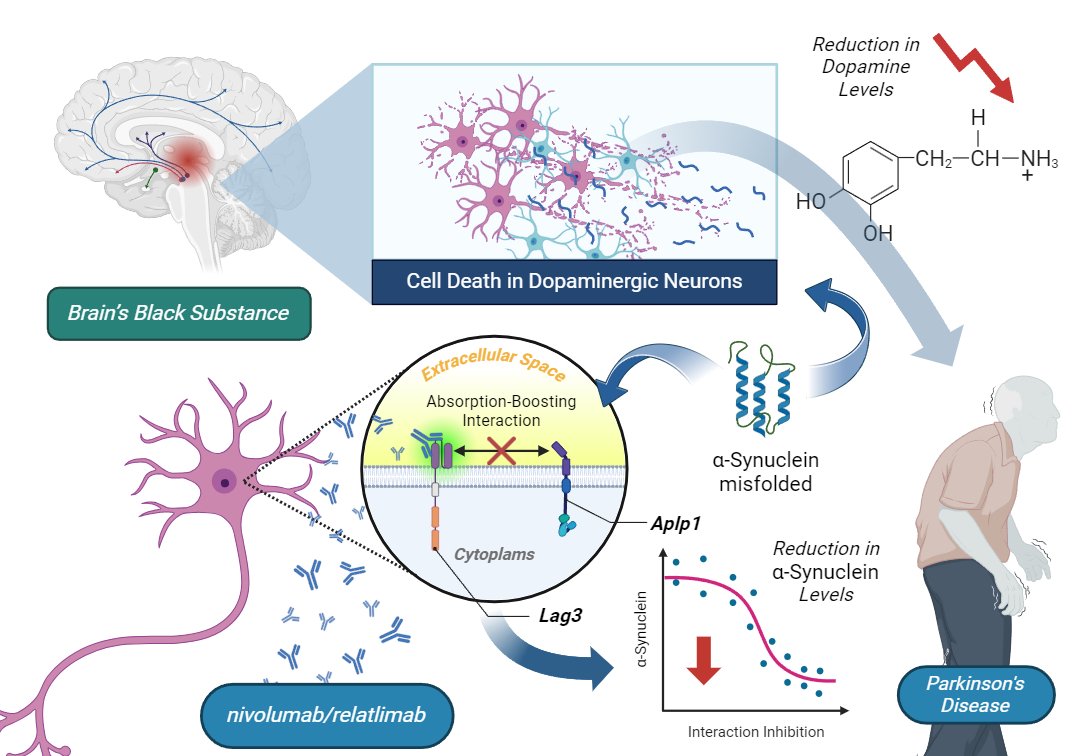A recent scientific discovery has opened a new door in the fight against Parkinson’s disease, suggesting that an FDA-approved cancer drug could be key in slowing its progression. Researchers have identified the crucial role of two proteins in the spread of the disease within the brain, and most surprisingly, one of them is already the target of an existing treatment. This finding not only provides a better understanding of Parkinson’s biology but also offers the possibility of accelerating the development of innovative therapies.
Parkinson’s is a neurodegenerative disease affecting more than 8.5 million people worldwide, making it the second most common after Alzheimer’s. It is a progressive movement disorder that, as it advances, causes tremors, stiffness, balance issues, and speech difficulties. There is currently no cure, and its origin is linked to the death of dopaminergic neurons in the substantia nigra, a brain region responsible for movement control. The primary hypothesis suggests that the accumulation of a protein called alpha-synuclein inside neurons leads to their deterioration and eventual death. However, until now, the exact mechanisms facilitating its spread among brain cells were not entirely understood.
Researchers from Johns Hopkins University have identified that two cell membrane proteins, Aplp1 and Lag3, play a key role in the absorption of misfolded alpha-synuclein within neurons. Previous studies had shown that Lag3 acts as a receptor that allows this pathological protein to enter cells, facilitating its spread and accelerating Parkinson’s progression. However, the new research revealed that Aplp1 is also an important player in this process. Both proteins can independently aid in the absorption of alpha-synuclein, but when working together, they significantly increase the amount of protein absorbed by neurons. In fact, the studies found that absorption was reduced by 90% when both proteins were absent, suggesting that interrupting this interaction could halt the spread of Parkinson’s within the brain.
The most relevant aspect of this discovery is that there is already an FDA-approved drug that blocks Lag3 activity, potentially disrupting disease progression. In animal model studies, researchers administered nivolumab/relatlimab, a drug used to treat melanoma, which contains an antibody targeting Lag3. The results were promising: the drug not only blocked the interaction between Lag3 and Aplp1 but also drastically reduced the formation of alpha-synuclein clumps inside neurons. This finding indicates that the medication could be a useful tool in slowing Parkinson’s and, potentially, other neurodegenerative diseases that also involve toxic protein accumulation in the brain.

Figure 1. The interaction between Aplp1 and Lag3 facilitates the absorption of alpha-synuclein, causing neuronal death. An antibody can block this interaction and slow down Parkinson’s progression.
The idea of repurposing a cancer drug to treat a neurodegenerative disease could significantly accelerate the development of a new therapy, as this drug has already undergone rigorous clinical trials to assess its safety in humans. Now, researchers plan to continue studies in animal models of Parkinson’s and Alzheimer’s to evaluate the impact of inhibiting Lag3 and Aplp1 on the progression of both diseases. If results remain favorable, this approach could move to human clinical trials in the future.
This breakthrough represents a new hope for people living with Parkinson’s. As research advances, the possibility of blocking disease progression with an already available treatment could change the lives of millions of patients worldwide. Although there is still a long way to go, this discovery brings us one step closer to finding effective strategies to combat neurodegeneration and improve the quality of life for those affected.
Main Reference:
Mao, X., Gu, H., Kim, D., Kimura, Y., Wang, N., Xu, E., Kumbhar, R., Ming, X., Wang, H., Chen, C., Zhang, S., Jia, C., Liu, Y., Bian, H., Karuppagounder, S. S., Akkentli, F., Chen, Q., Jia, L., Hwang, H., … Dawson, T. M. (2024). Aplp1 interacts with Lag3 to facilitate transmission of pathologic α-synuclein. Nature Communications, 15(1), 1–19. https://doi.org/10.1038/s41467-024-49016-3
Other References:
Braak, H., Del Tredici, K., Rüb, U., de Vos, R. A., Jansen Steur, E. N., & Braak, E. (2003). Staging of brain pathology related to sporadic Parkinson’s disease. Neurobiology of aging, 24(2), 197–211. https://doi.org/10.1016/s0197-4580(02)00065-9
Barker, R. A., & Williams-Gray, C. H. (2016). Review: The spectrum of clinical features seen with alpha synuclein pathology. Neuropathology and applied neurobiology, 42(1), 6–19. https://doi.org/10.1111/nan.12303
Li, W., Englund, E., Widner, H., Mattsson, B., van Westen, D., Lätt, J., Rehncrona, S., Brundin, P., Björklund, A., Lindvall, O., & Li, J. Y. (2016). Extensive graft-derived dopaminergic innervation is maintained 24 years after transplantation in the degenerating parkinsonian brain. Proceedings of the National Academy of Sciences of the United States of America, 113(23), 6544–6549. https://doi.org/10.1073/pnas.1605245113


